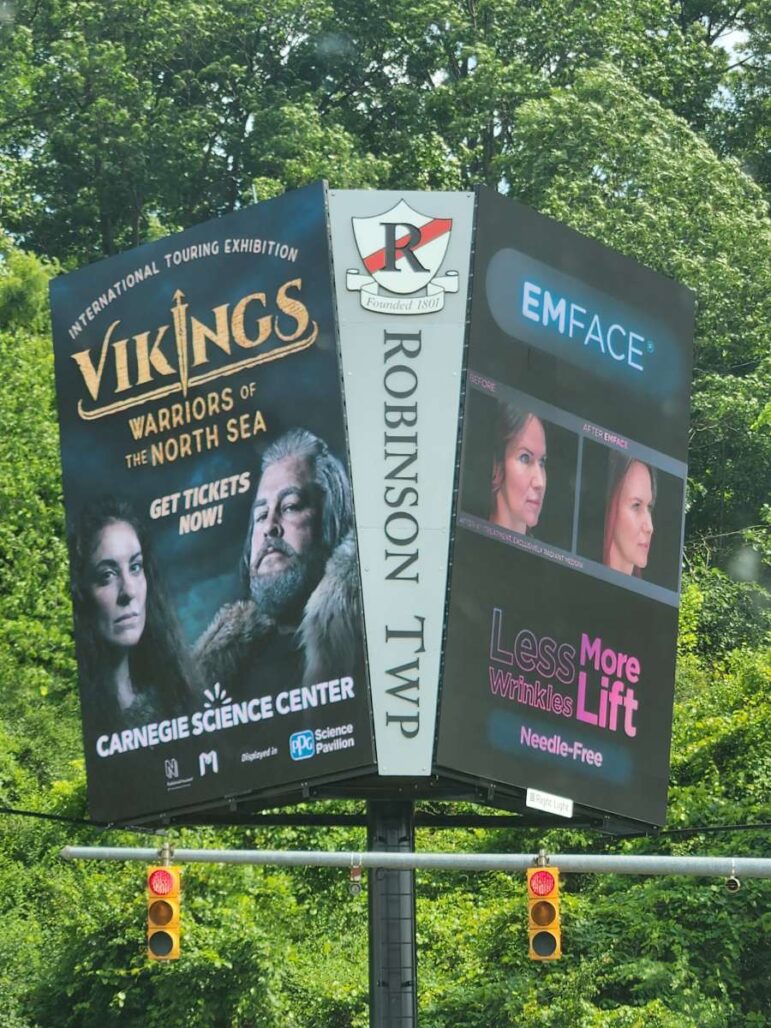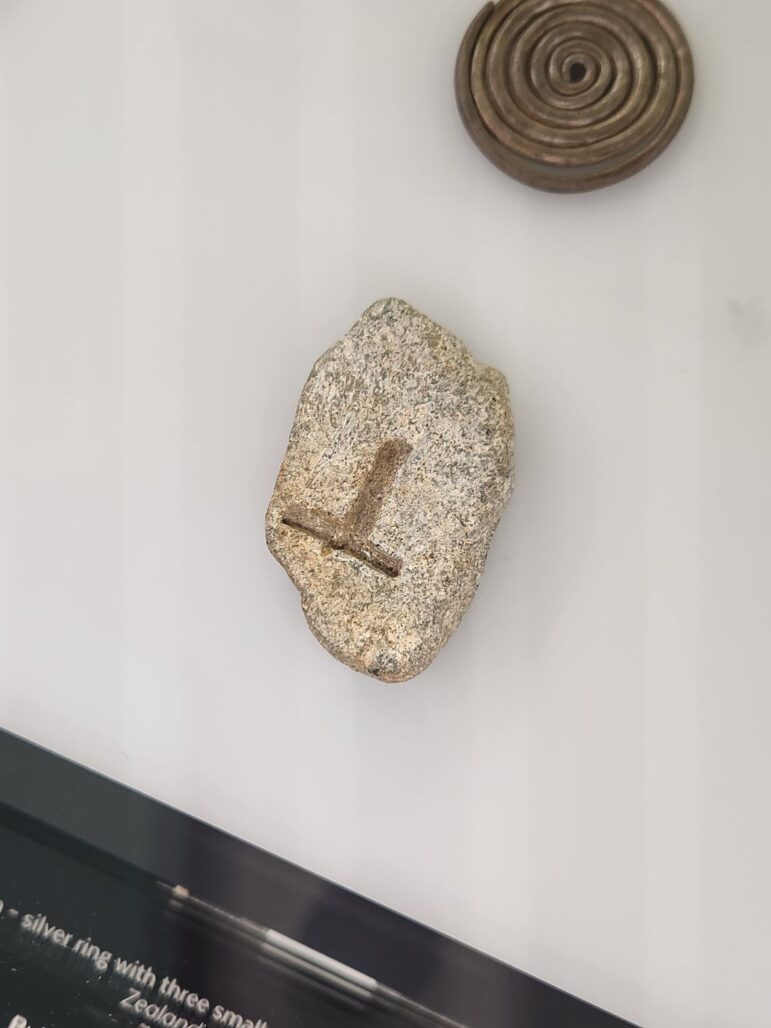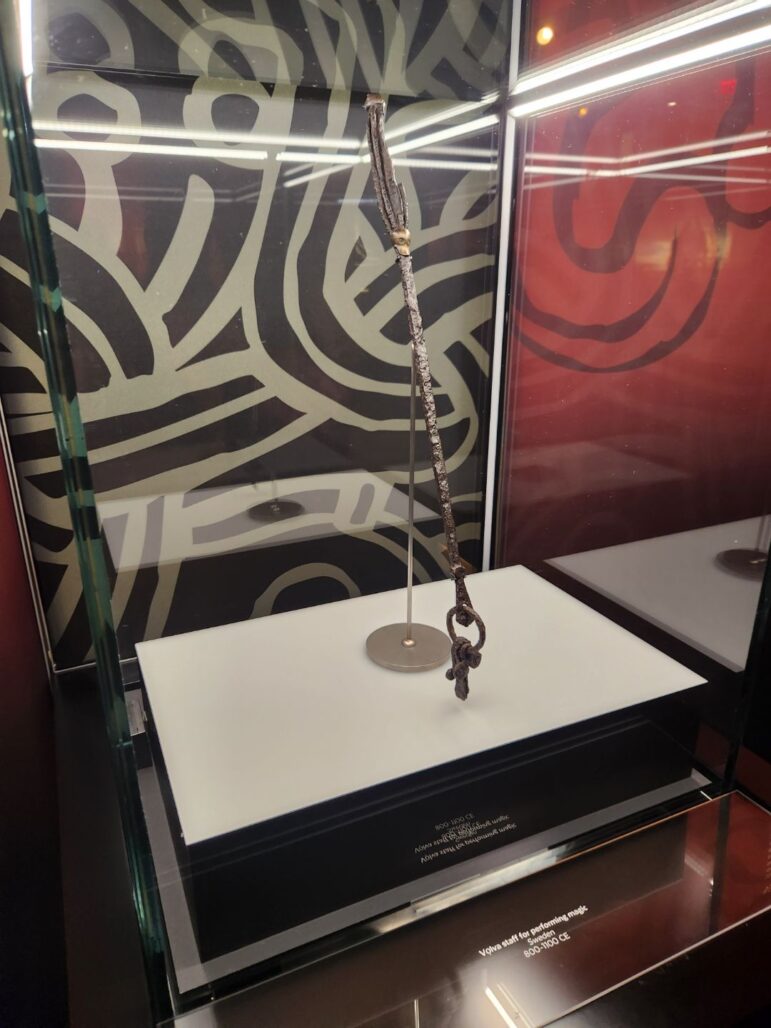
Today’s offering comes to us from Sprocket Wagner (she/her.) Sprocket is a journalist devoted to bringing diverse and equitable coverage to topics of religion and spirituality. She’s an eclectic Pagan, a Witch, and an aspiring scholar of interfaith theology. Find her on Mastodon, or on her website, Interfaith Heathen.
PITTSBURGH – When I saw an advertisement for “Vikings: Warriors of the North Sea” at the Carnegie Science Center on a local billboard, I let out a heavy sigh, irritated at both the billboard and my own compulsion to go see it. The title sat at the top in a harsh font with a sword for an “I,” and beneath were a pair of dour Vikings before a gloomy background. While there were no horned helmets, I was immediately reminded of pop culture imaginings of hyper-masculine pillagers.

An advertisement for “Vikings: Warriors of the North Sea” next to an ad for cosmetic surgery [S. Wagner]
The exhibit’s website, however, makes clear that many of these irritants were merely meant to draw in the public. A major goal of the exhibition is to move past inaccurate portrayals of Vikings and portray “a fuller image of Vikings as traders, settlers, explorers, and highly qualified craftsmen, architects, and engineers.” In fact, only one of seven segments of the exhibit has anything to do with war. While I do still have a number of other gripes with the exhibit as a Norse Pagan, this already puts the exhibit a step above most of its ilk.
Upon entering the exhibit, I was met with a short, live-action video introducing its content. It was super cheesy, but that’s not to its detriment. It did portray the ransacking of a monastery, but this seems primarily meant to remind us of who wrote the surviving accounts.
Immediately following was a section about boats and sailing, which was easily one of my favorite parts of the exhibition. It included real pieces of ships, a reconstruction of a burial boat, and a touch screen on which visitors gather materials and construct a longship. I appreciated that gathering the materials oneself puts into context how long and expensive the process was.
Then came the section about trading, which housed artifacts of trade, such as scales and trade goods, as well as life as a traveling trader. After that was the section on warriors, which included both real weapons in cases and replica weapons and armor that could be touched and lifted. While I was disappointed to be unable to swing the sword, as it was chained pretty close to the table, it was nice to get a feel for the weight and balance.
Around the corner were clothes that one could try on. I’m quite tall, and struggled to fit into most of them, but the cloaks fit just fine and were the most fun to wear. This area also housed playable games of Hnefatafl. The text on the walls acknowledged the gendering of Norse society, as well as class structure and the presence of slaves. In fact, the next section was entirely devoted to class and wealth disparities.

A stone mold for Mjolnir pendents from the “Vikings: Warriors of the North Sea” exhibit [S. Wagner]
Then came the part I was most excited for – “Viking Mind – Gods and Beliefs.” This section of the exhibit housed two nicely animated videos portraying two notable Scandinavian myths: the creation story and Ragnarok. The former was straightforward, and exactly what I would have expected from condensing the story down into a minute. The latter was a pleasant surprise in that it completely left out the beginning of the story and focused on the actual events of Ragnarok and its aftermath.
While this could have been a result of conflicting accounts of this section of the myth, in combination with a few other choices it felt like a purposeful attempt to avoid demonizing Loki. There were few mentions of him, but one that I distinctly remember said that the other gods “tolerated Loki for his abilities,” which is fair.
I was disappointed that the majority of the section discussing religion was dedicated to Christianity, and portrayed the two faiths as living in harmony. It felt as though this downplayed the destructive effects Christianization had on our surviving records of religious and magical practices. This is in part due to a massive plaster cast of the Jelling Stone, the famous rune stone created by the Christian king of Denmark, Harald Bluetooth, being the main focus of the room. While it was impressive, and the other Christian artifacts like the Aby Crucifix were definitely worthy of display, the pagan artifacts and practices should have been in their own section.
There were also objects throughout the exhibit that looked like objects of faith or portrayals of mythological creatures that were simply given labels like “horned figure.” This could simply be due to a lack of exact evidence of what these objects were for, so I don’t think it was malicious, but it was certainly a sore spot for me.
There were, however, some things very worth seeing as a Pagan in this section. These included a mask used in an ecstatic ritual to Odin, a wide array of Mjolnir pendants and a stone mold used to cast them, and most importantly, a real völva staff from Sweden. These are things that I would otherwise never be so close to, and I could feel them all pulling at me, calling to me, especially the staff. Frankly, that alone made the whole thing worth it.

The völva staff from the “Vikings: Warriors of the North Sea” exhibition [S. Wagner]
I’d also like to briefly note the offerings in the gift shop. There were some raven bookends that I loved, some jewelry including some decent Mjolnirs, resin statuettes that wouldn’t look out of place on an altar, and stickers including one that said “May the Norse be with you” in the Star Wars font. The latter two I picked up for a reasonable price. They were advertised as being only available in person, and while I did find the sticker online, for the rest that seems to hold true.
Overall, I would thoroughly recommend seeing this exhibit if it travels near you. It’s a chance to experience artifacts in person that many in the United States would never get a chance to see otherwise. It is a bit text-heavy, but Norse Pagans are generally used to that, and it’s broken up nicely by videos and interactive activities. The 20 dollars I paid for entry (separate from general admission) might be a bit steep for a casual museum-goer, but well worth it for Pagans and enthusiasts, and the Carnegie Science Center has a discounted rate for both tickets.
“Vikings: Warriors of the North Sea” is on exhibition at the Carnegie Science Center in Pittsburgh through September 4th.
The Wild Hunt is not responsible for links to external content.
To join a conversation on this post:
Visit our The Wild Hunt subreddit! Point your favorite browser to https://www.reddit.com/r/The_Wild_Hunt_News/, then click “JOIN”. Make sure to click the bell, too, to be notified of new articles posted to our subreddit.
